 Early Literacy Aside--Explain: Researchers have noted one of the areas of early literacy to be print motivation. This means having an interest in and enjoying books. Children are more likely to have print otivation when they are involved with the story. As I share books today, you'll see different ways you can keep your children interested as you read with them.Read Down by the Cool of the Pool
Early Literacy Aside--Example: Having a child say a repeated phrase with you throughout the book keeps him involved and it's an easy way to you to support print motivation.
Early Literacy Aside--Empower: Remember that promoting literacy does not mean creating a school-like setting in your home, but rather taking advantage of the opportunities in your everyday life.
Submitted by Emily Little, Public Library of Charlotte and Mechlenburg County (NC)
Early Literacy Aside--Explain: Researchers have noted one of the areas of early literacy to be print motivation. This means having an interest in and enjoying books. Children are more likely to have print otivation when they are involved with the story. As I share books today, you'll see different ways you can keep your children interested as you read with them.Read Down by the Cool of the Pool
Early Literacy Aside--Example: Having a child say a repeated phrase with you throughout the book keeps him involved and it's an easy way to you to support print motivation.
Early Literacy Aside--Empower: Remember that promoting literacy does not mean creating a school-like setting in your home, but rather taking advantage of the opportunities in your everyday life.
Submitted by Emily Little, Public Library of Charlotte and Mechlenburg County (NC)
Mama Cat Has Three Kittens by Denise Fleming
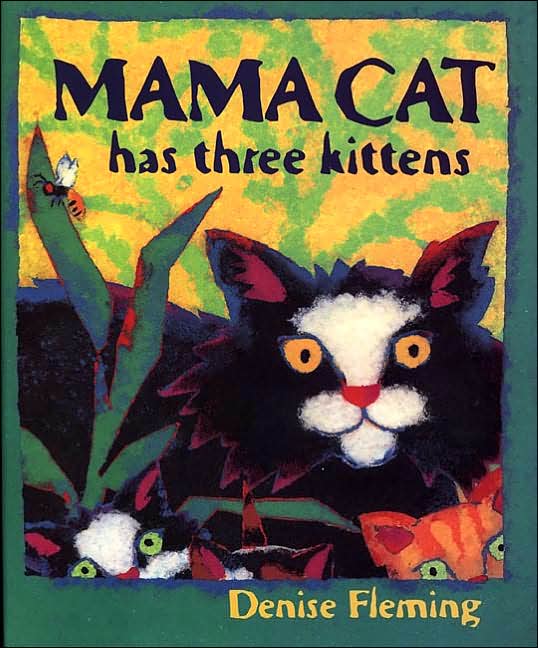 Cat Puppet: There's a cat in my hat, a cat in my hat, a cat in my hat today (do twice). What does the kitty cat say? [cat puppet says meow]Read Mama Cat Has Three Kittens
Early Literacy Aside--Example: When children hear rhymes, rhythms and sounds of animals, it helps them develop phonological awareness, hearing the smaller sounds in words. This is a skill that will help them as they begin to read.
Early Literacy Aside--Empower: Keep doing rhymes with things in your children's world. Today we did cat in my hat. You can do ball in the hall or star on my car (give a star sticker).
Cat Puppet: There's a cat in my hat, a cat in my hat, a cat in my hat today (do twice). What does the kitty cat say? [cat puppet says meow]Read Mama Cat Has Three Kittens
Early Literacy Aside--Example: When children hear rhymes, rhythms and sounds of animals, it helps them develop phonological awareness, hearing the smaller sounds in words. This is a skill that will help them as they begin to read.
Early Literacy Aside--Empower: Keep doing rhymes with things in your children's world. Today we did cat in my hat. You can do ball in the hall or star on my car (give a star sticker).
Submitted by Cathy Cartedge, Public Library of Charlotte and Mechlenburg County (NC)
Swim, Little Wombat, Swim by Charles Fuge
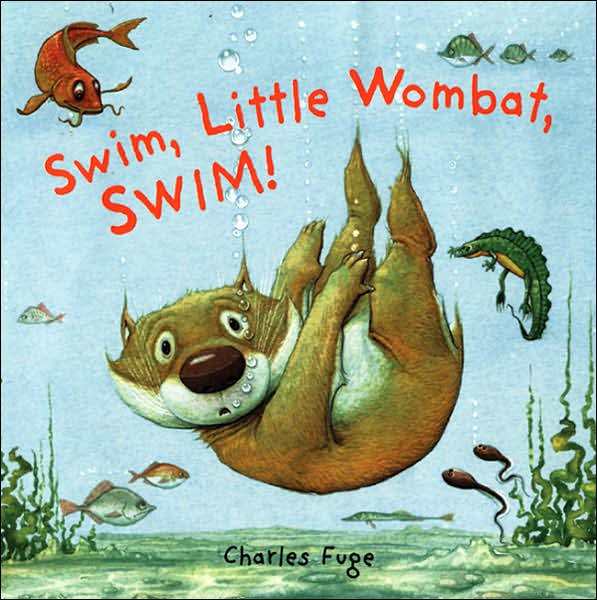
Submitted by Larisa Martin, Public Library of Charlotte and Mechlenburg County (NC)
Three Bears by Byron Barton
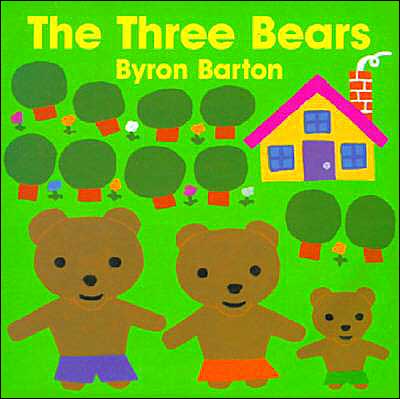 Early Literacy Aside--Explain: Narrative skills is the ability to talk about events and tell stories. Having children tell you what they are thinking, talk about things that happen, or tell you stories is later going to help them understand what they read.Read The Three Bears and have children help you retell the story using props or a flannel board.
Early Literacy Aside--Example: Retelling stories helps children understand what they read. Using props found around home can help children remember and retell stories.
Early Literacy Aside--Empower: When children do what is called dramatic play, when they act out stories, this kind of play helps children understand the structure and story and helps them understand the story itself. Play is a great way to support later reading.
Early Literacy Aside--Explain: Narrative skills is the ability to talk about events and tell stories. Having children tell you what they are thinking, talk about things that happen, or tell you stories is later going to help them understand what they read.Read The Three Bears and have children help you retell the story using props or a flannel board.
Early Literacy Aside--Example: Retelling stories helps children understand what they read. Using props found around home can help children remember and retell stories.
Early Literacy Aside--Empower: When children do what is called dramatic play, when they act out stories, this kind of play helps children understand the structure and story and helps them understand the story itself. Play is a great way to support later reading.
Submitted by Sue Smith, Independence Library, Public Library of Charlotte and Mechlenburg County (NC)
Shape Bee

Early Literacy Aside--Example: Before children learn letters, they learn shapes. Let them play with shapes to develop later letter knowledge. Flannel Board: Do Shape Bee on flannel board. See attachment for pattern Shape Bee pattern Craft Activity: You can use the pattern as a basis to have the children make their own Shape Bee. Early Literacy Aside--Empower: Wherever you go today, look for the letter B, on signs, in books, on products. Then you can do the same with other letters throughout the week.
Submitted by Erin Nguyen, Public Library of Charlotte and Mechlenburg County (NC)
Way Down Deep in the Deep Blue Sea by Jan Peck
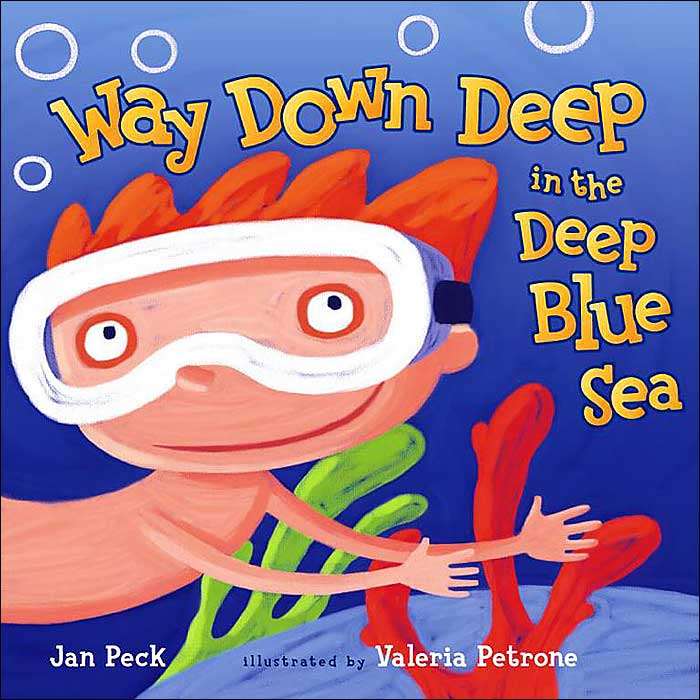 Introduction: I am going to read our next book, Way Down Deep in the Deep Blue Sea by Jan Peck. Then you can tell it with me on the flannel board.Read Way Down Deep in the Deep Blue Sea. Repeat some of the rhymes to help them remember.
Flannel Board: As you put up pieces on the flannel board have the children retell the story.
Early Literacy Aside--Example: Using the flannel board pieces as a clue will help your child remember the story to retell it. Encouraging your children to retell stories helps them to both remember and to understand them. It is a first step in helping them to later understand what they will read.
Introduction: I am going to read our next book, Way Down Deep in the Deep Blue Sea by Jan Peck. Then you can tell it with me on the flannel board.Read Way Down Deep in the Deep Blue Sea. Repeat some of the rhymes to help them remember.
Flannel Board: As you put up pieces on the flannel board have the children retell the story.
Early Literacy Aside--Example: Using the flannel board pieces as a clue will help your child remember the story to retell it. Encouraging your children to retell stories helps them to both remember and to understand them. It is a first step in helping them to later understand what they will read.
Submitted by Stem Saunders, Steele Creek Library, Public Library of Charlotte and Mechlenburg County (NC)
Itsy Bitsy Spider Rhyme
 Early Literacy Aside--Explain: Talking with children as you read books and share rhymes can add to the words they know and to their knowledge if YOU use words they are not familiar with or add information they may not yet know. Both adding to their vocabulary and to their knowledge will help them understand what they read when they learn to read. Say/sing the rhyme with actions:
The itsy bitsy spider went up the waterspout.
Down came the rain and washed the spider out.
Out came the sun and dried up all the rain.
And the itsy bitsy spider climbed up the spout again.
Early Literacy Aside--Example: Here are some examples of the kinds of questions you can ask your children. Then add to what they say to introduce new words and information. [Then you ask the children a couple of questions. Some possibilities are below. Be careful to keep it fun and engaging, not like a test of knowledge.]
Where was the spider going?
What happened when the rain started?
Where do you think spiders live?
Have you seen a spider? Where? What was it doing?
What do you know about spiders?
Early Literacy Aside--Empower: Sometimes we do not know much about some of the topics our children are interested in. We have lots of factual books on a variety of topics like spiders, snakes, dinosaurs, trains, and more. Just let us know what you and your children would like to read about. These books not only make reading enjoyable because yuou are building on your child's interest, you are also setting a good foundation for helping them learn new words and knowledge.
Early Literacy Aside--Explain: Talking with children as you read books and share rhymes can add to the words they know and to their knowledge if YOU use words they are not familiar with or add information they may not yet know. Both adding to their vocabulary and to their knowledge will help them understand what they read when they learn to read. Say/sing the rhyme with actions:
The itsy bitsy spider went up the waterspout.
Down came the rain and washed the spider out.
Out came the sun and dried up all the rain.
And the itsy bitsy spider climbed up the spout again.
Early Literacy Aside--Example: Here are some examples of the kinds of questions you can ask your children. Then add to what they say to introduce new words and information. [Then you ask the children a couple of questions. Some possibilities are below. Be careful to keep it fun and engaging, not like a test of knowledge.]
Where was the spider going?
What happened when the rain started?
Where do you think spiders live?
Have you seen a spider? Where? What was it doing?
What do you know about spiders?
Early Literacy Aside--Empower: Sometimes we do not know much about some of the topics our children are interested in. We have lots of factual books on a variety of topics like spiders, snakes, dinosaurs, trains, and more. Just let us know what you and your children would like to read about. These books not only make reading enjoyable because yuou are building on your child's interest, you are also setting a good foundation for helping them learn new words and knowledge.
Submitted by a library staff person at Public Library of Charlotte and Mechlenburg County (NC)
Catch That Goat by Polly Alakija
 Early Literacy Aside--Explain: Today we're going to highlight narrative skills. This is the ability to describe things and to talk about events and tell stories. Researchers have noted this skill as one of the early literacy skills that will help your child be ready to read. It helps children understand what they will read.Read Clay Boy by Mirra Ginsburg
Flannel Board of Three Billy Goats Gruff
Early Literacy Aside--Example: In Catch That Goat we're going to say part of the story together. Acting out or repeating parts of stories helps children internalize and understand what is happening in the story. This will help them tell the story back to you, especially with their favorite stories which they like to hear over and over again. OK, now, let's all say together, "Have you seen my goat?" and "No!" Great!
Read Catch That Goat
Song: "Spaghetti Legs" on Jim Gill Sings the Sneezing Song and Other Contagious Tunes
Rhyme: 1, 2, 3, 4, 5 Once I Caught a Fish Alive
Read Oh, Look by Patricia Polacco
Early Literacy Aside--Empower: Today we read some of my favorite stories. Practice telling and retelling stories. If you let your child watch television, talk about the shows you watch together. Have them tell you what happened in the show. This will help them talk aout what is happening in books also. Talking about what they know and retelling events and stories helps them understand what is being read.
Early Literacy Aside--Explain: Today we're going to highlight narrative skills. This is the ability to describe things and to talk about events and tell stories. Researchers have noted this skill as one of the early literacy skills that will help your child be ready to read. It helps children understand what they will read.Read Clay Boy by Mirra Ginsburg
Flannel Board of Three Billy Goats Gruff
Early Literacy Aside--Example: In Catch That Goat we're going to say part of the story together. Acting out or repeating parts of stories helps children internalize and understand what is happening in the story. This will help them tell the story back to you, especially with their favorite stories which they like to hear over and over again. OK, now, let's all say together, "Have you seen my goat?" and "No!" Great!
Read Catch That Goat
Song: "Spaghetti Legs" on Jim Gill Sings the Sneezing Song and Other Contagious Tunes
Rhyme: 1, 2, 3, 4, 5 Once I Caught a Fish Alive
Read Oh, Look by Patricia Polacco
Early Literacy Aside--Empower: Today we read some of my favorite stories. Practice telling and retelling stories. If you let your child watch television, talk about the shows you watch together. Have them tell you what happened in the show. This will help them talk aout what is happening in books also. Talking about what they know and retelling events and stories helps them understand what is being read.
Submitted by Vera Beers, Public Library of Charlotte and Mechlenburg County (NC)
We're Going on a Bear Hunt by Michael Rosen
 Early Literacy Aside--Explain: Teddy Bear puppet talking to introduce the skill: Today we are going to develop your children's story knowledge and thinking skills. These skills help them to understand what they read when they learn to read. [Then hide the bear in a black piece of paper like a cave.]Read We're Going on a Bear Hunt, putting motions to the words.
Activity: Give children colored stips of paper to represent each of the scenes in the book. Connect each color strip with each scene; for example: blue for river, green for grass, brown for mud. Now, retell the story using first, second, third, etc.--first we went to the river and as they say the phrase they place the blue colored strip down, and so on. For the last action where they go home, have a piece of material to represent a blanket.
Early Literacy Aside--Example: With this activity what your child knows, by helping them in a couple of ways--retelling the story so they understand how stories work and also with sequencing and connecting colors with actions which develops their thinking skills.
Early Literacy Aside--Explain: Teddy Bear puppet talking to introduce the skill: Today we are going to develop your children's story knowledge and thinking skills. These skills help them to understand what they read when they learn to read. [Then hide the bear in a black piece of paper like a cave.]Read We're Going on a Bear Hunt, putting motions to the words.
Activity: Give children colored stips of paper to represent each of the scenes in the book. Connect each color strip with each scene; for example: blue for river, green for grass, brown for mud. Now, retell the story using first, second, third, etc.--first we went to the river and as they say the phrase they place the blue colored strip down, and so on. For the last action where they go home, have a piece of material to represent a blanket.
Early Literacy Aside--Example: With this activity what your child knows, by helping them in a couple of ways--retelling the story so they understand how stories work and also with sequencing and connecting colors with actions which develops their thinking skills.
Submitted by Irania Patterson, Public Library of Charlotte and Mechlenburg County (NC) and Saroj Ghoting
Train Song by Harriet Ziefert
 Early Literacy Aside--Explain: Researchers have found that one of ways you can support later reading is by helping children hear the smaller sounds in words. This skill is called phonological awareness. Today I'll point out some thing you can do to help your childrne develop this skill.Early Literacy Aside--Example: Rhyming is one way that children learn to hear that words are made up of smaller parts. By doing rhymes with your children you are setting the stage for them to sound out words to read.
Read Train Song
Early Literacy Aside--Empower: Find a book at home which has rhyming words and see if your child can identify words that rhyme. If you don't have a rhyming book, just read a book and then pick a word and think of rhyming words together.
Early Literacy Aside--Explain: Researchers have found that one of ways you can support later reading is by helping children hear the smaller sounds in words. This skill is called phonological awareness. Today I'll point out some thing you can do to help your childrne develop this skill.Early Literacy Aside--Example: Rhyming is one way that children learn to hear that words are made up of smaller parts. By doing rhymes with your children you are setting the stage for them to sound out words to read.
Read Train Song
Early Literacy Aside--Empower: Find a book at home which has rhyming words and see if your child can identify words that rhyme. If you don't have a rhyming book, just read a book and then pick a word and think of rhyming words together.
Submitted by Rita Doran, Dayton Metro (OH) Public Library
Flora's Surprise by Debi Gliori
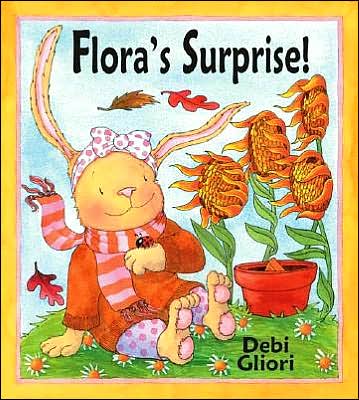 Early Literacy Aside--Example: This is a favorite book of mine. It shows children enjoying planting seeds and also how children think, in interesting ways. Let your child know when you are reading a favorite book of yours. This helps develop print motivation.Read Flora's Surprise
Early Literacy Aside--Example: This is a favorite book of mine. It shows children enjoying planting seeds and also how children think, in interesting ways. Let your child know when you are reading a favorite book of yours. This helps develop print motivation.Read Flora's Surprise
Submitted by Marie Kupchinski, Buchanan Branch Library, Saskatchewan (Canada) Public Library
Song for Introduction
Storytime Announcement (tune: Yankee Doodle)
Please turn down your cell phones now,
So they will not distract us.
Please join along and sing the songs,
It always helps to practice.
Storytime can help us read.
Storytime is what we need.
Storytime is lots of fun!
Storytime’s for everyone.
EarlyLiteracy Aside--Explain: When you participate in storytime with your children you send them the message that what we do in storytime is important. You let them know that reading is important and enjoyable, worth doing. They love to do things with you. By being present you help to support their print motivation, their enjoyment of books and reading. This will later help them stick with learning to read even if it is difficult for them.
Submitted by Mary Binda, Augusta County (VA) Public Library
Who Wants a Valentine by Linda Lowery
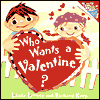 Early Literacy Aside--Explain: Researchers have found that children with a large vocabulary, who have heard a lot of different words, find it easier to learn to read when the time comes.Read Who Wants a Valentine?
Early Literacy Aside--Example: Don't replace unfamiliar words, use them and explain them if necessary. For example: "Tea for two?/ I decline./ I don't want a valentine." I didn't change the word decline, I explained it: decline means to say no.
Early Literacy Aside--Explain: Researchers have found that children with a large vocabulary, who have heard a lot of different words, find it easier to learn to read when the time comes.Read Who Wants a Valentine?
Early Literacy Aside--Example: Don't replace unfamiliar words, use them and explain them if necessary. For example: "Tea for two?/ I decline./ I don't want a valentine." I didn't change the word decline, I explained it: decline means to say no.
Submitted by Megan Brandmaier, Cincinnati (OH) Public Library
Old Macdonald Had a Farm Flannel Board
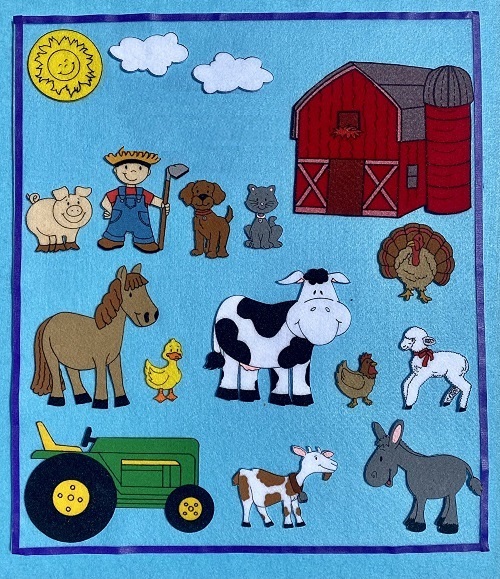 Pass out flannel board pieces of fam animals. Play or sing "Old Macdonald Had a Farm" . When a child hears the animal he/she is holding, that child comes up to place the animal piece on the flannel board.Early Literacy Aside--Example: Having your children hear and make the sounds of the animals is one enjoyable way to help them develop phonological awareness, to eventually be able to hear the smaller sounds in words.
Take-Home Activity: Hand out shapes of animals for families to take home.
Early Literacy Aside--Empower: Parents, you can use these animal shapes to make animal sounds with your children and home and sing the song with them to practice the skill of phonological awareness.
Pass out flannel board pieces of fam animals. Play or sing "Old Macdonald Had a Farm" . When a child hears the animal he/she is holding, that child comes up to place the animal piece on the flannel board.Early Literacy Aside--Example: Having your children hear and make the sounds of the animals is one enjoyable way to help them develop phonological awareness, to eventually be able to hear the smaller sounds in words.
Take-Home Activity: Hand out shapes of animals for families to take home.
Early Literacy Aside--Empower: Parents, you can use these animal shapes to make animal sounds with your children and home and sing the song with them to practice the skill of phonological awareness.
Submitted by Helen Patzer, Dayton (OH) Metro Library, Northtown-Shiloh Branch.
Fiddle I Fee Song
Sing the song Fiddle I Fee[If you like you can do it as a "clothesline song". Put string or a rope across the room. As each animal is added, hang it on the clothesline (from left ot right as the children see it). This helps them remember the sequence.
Bought me a cat and the cat pleased me,
I fed my cat under yonder tree.
Cat goes fiddle-i-fee.
Bought me a duck and the duck pleased me, I fed my duck under yonder tree.
Duck goes quack, quack,
Cat goes fiddle-i-fee.
Keep adding verses one-by-one:
Bought me a dog and the dog pleased me,
I fed my dog under yonder tree.
Dog goes bow-wow, bow-wow,
Horse goes neigh, neigh,
Cow goes moo, moo,
Pig goes oink, oink,
Sheep goes baa, baa,
Goose goes hissy, hissy,
Duck goes quack, quack,
Cat goes fiddle-i-fee.
Early Literacy Aside--Example: This song includes some silly animal sounds which is the beginning of making the child aware of the sounds within words.
I fed my duck under yonder tree.
Duck goes quack, quack,
Cat goes fiddle-i-fee.
Keep adding verses one-by-one:
Bought me a dog and the dog pleased me,
I fed my dog under yonder tree.
Dog goes bow-wow, bow-wow,
Horse goes neigh, neigh,
Cow goes moo, moo,
Pig goes oink, oink,
Sheep goes baa, baa,
Goose goes hissy, hissy,
Duck goes quack, quack,
Cat goes fiddle-i-fee.
Early Literacy Aside--Example: This song includes some silly animal sounds which is the beginning of making the child aware of the sounds within words.
Submitted by Carol Miller, Dayton (OH) Metro Library System
Train Storytime
Train ThemeStorytime Handout with Early Literacy Tip on Vocabulary
trainparenthandout1.pdf Submitted by Anna Hancock, Cincinnati (OH) Public Library
Submitted by Anna Hancock, Cincinnati (OH) Public Library
Tickle Teddy by David Ellwand
 Early Literacy Aside--Explain: Rhyming is one way that children learn to hear that words are made up of smaller parts. By doing rhymes with them you are supporting phonological awareness. This skill helps them when they later try to sound out words to read. And it's fun too.Read the book.
Early Literacy Aside--Example: Even though young children do not understand the meanings of the rhymes, it is important for them to hear them. By six months babies are already able to recognize the sounds of the languages they hear. They also are losing those sounds they don't hear even though they were born able to learn to make them.
Submitted by Sandy Smith, Muskingum County (OH) Library System
Early Literacy Aside--Explain: Rhyming is one way that children learn to hear that words are made up of smaller parts. By doing rhymes with them you are supporting phonological awareness. This skill helps them when they later try to sound out words to read. And it's fun too.Read the book.
Early Literacy Aside--Example: Even though young children do not understand the meanings of the rhymes, it is important for them to hear them. By six months babies are already able to recognize the sounds of the languages they hear. They also are losing those sounds they don't hear even though they were born able to learn to make them.
Submitted by Sandy Smith, Muskingum County (OH) Library System
Guess How Much I Love You by Sam McBratney
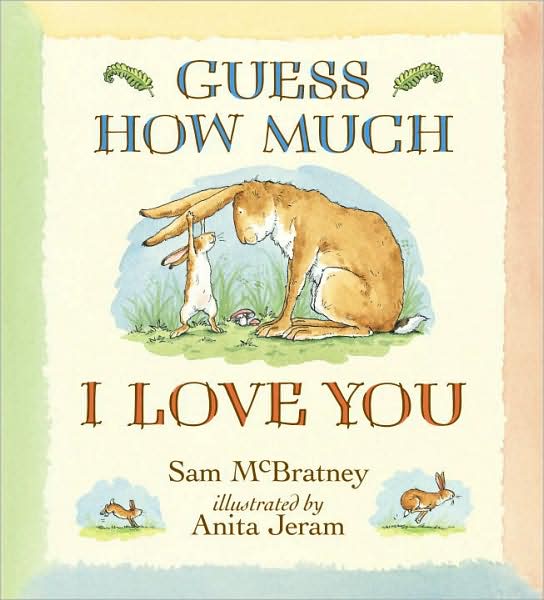 Our next book is Guess How Much I Love You by Sam McBratney.Early Literacy Aside--Example: This is my favorite book from my son's early years. We would read this one every night and we both knew the book word for word. Having a positive interaction with books and reading is an example of print motivation, helping children to associate reading with enjoyment.
Submitted by Karri Marshall, Lane (OH) Public Libraries
Our next book is Guess How Much I Love You by Sam McBratney.Early Literacy Aside--Example: This is my favorite book from my son's early years. We would read this one every night and we both knew the book word for word. Having a positive interaction with books and reading is an example of print motivation, helping children to associate reading with enjoyment.
Submitted by Karri Marshall, Lane (OH) Public Libraries
Five Little Kittens Rhyme
Say the rhyme together. Act out the lyrics.Five Little Kittens
Five little kittens sleeping on a chair
One rolled off, leaving four there.
Four little kittens, one climbed a tree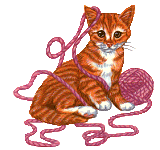 To look in a birds nest; then there were three.
Three little kittens wondered what to do.
One saw a mouse, and then there were two.
Two little kittens playing near a wall.
One little kitten chased a red ball.
One little kitten with fur soft as silk,
Left all alone to drink a dish of milk.
To look in a birds nest; then there were three.
Three little kittens wondered what to do.
One saw a mouse, and then there were two.
Two little kittens playing near a wall.
One little kitten chased a red ball.
One little kitten with fur soft as silk,
Left all alone to drink a dish of milk.
Early Literacy Aside--Example: We are acting out the lyrics. After we do it a few times, I will see if the children can help me recall the actions and say the rhyme themselves. This is a form of narrative skills, saying the rhyme in order and using the actions to help them recall it, a first step in later understanding what they read.
Submitted by Anna Hancock, Cincinnati (OH) Public Library
Penguins by Liz Pichon
 [New words in this book: activities, camera lens, grinning, waddle, amazing, developed]Listen to the interesting words in this book as I read it.
Read the book.
Early Literacy Aside--Example: Hearing new words in books helps your child learn lots of words and the more vocabulary they learn the more they will understand what they will read.
[New words in this book: activities, camera lens, grinning, waddle, amazing, developed]Listen to the interesting words in this book as I read it.
Read the book.
Early Literacy Aside--Example: Hearing new words in books helps your child learn lots of words and the more vocabulary they learn the more they will understand what they will read.
Submitted by Lou Ann Studer, Lebanon (OH) Public Library
